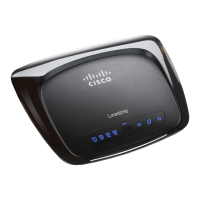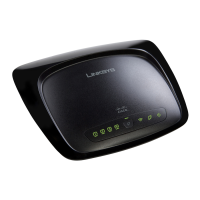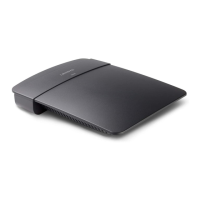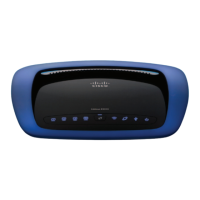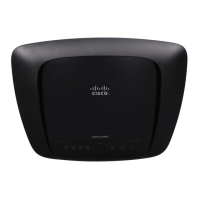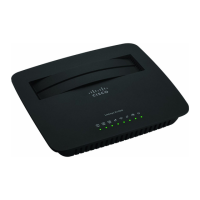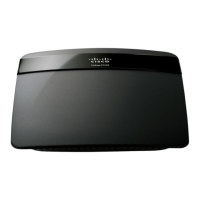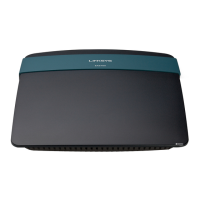
Do you have a question about the Cisco Linksys WRV54G and is the answer not in the manual?
| Model | WRV54G |
|---|---|
| Category | Wireless Router |
| Wireless Standard | 802.11b/g |
| Frequency Band | 2.4 GHz |
| Maximum Wireless Speed | 54 Mbps |
| Security | WEP, WPA, WPA2 |
| VPN Support | Yes |
| Antenna Type | External |
| Weight | 1.1 lbs |
| Ports | 4 x 10/100 Ethernet |
| Antenna | 2 |
| Firewall | SPI |
Explains how to use the guide and identifies special symbols and definitions.
Introduces the Wireless-G VPN Broadband Router and its capabilities.
Details the content covered in each chapter and appendix of the user guide.
Explains the basic function of a router and its role in connecting networks.
Defines IP addresses and explains static vs. dynamic assignment.
Describes how dynamic IP addresses are assigned by a DHCP server.
Explains the role of DHCP servers in assigning IP addresses automatically.
Discusses the security risks of wireless networking and the need for VPNs.
Explains what a VPN is and its purpose in securing data transmission.
Describes how two VPN routers can establish a secure tunnel for network communication.
Explains how a computer with VPN client software can connect to a VPN router.
Identifies and describes the ports and buttons on the back panel of the router.
Explains the LEDs on the front panel and their meanings for network activity.
Outlines the steps for setting up the router and configuring networked PCs.
Provides step-by-step instructions for connecting the router to a PC using an Ethernet cable.
Provides step-by-step instructions for connecting the router to a PC wirelessly.
Guides on configuring computers to communicate with the router via IP addresses.
Step-by-step instructions for configuring network settings on Windows 98/Me.
Step-by-step instructions for configuring network settings on Windows 2000.
Step-by-step instructions for configuring network settings on Windows XP.
Introduces the router's web-based utility and key configuration screens.
Displays information about the router and its local network connections.
Instructions on how to access the router's configuration interface via a web browser.
Introduces the main setup tab for configuring internet and network settings.
Configuration options for static IP internet connection types.
Configuration options for PPPoE internet connection types, common for DSL.
Configuration options for PPTP internet connection types, mainly for Europe.
Details network setup configurations including Gateway, Local IP, and DHCP server settings.
Allows selection of wireless network mode, name (SSID), and channel.
Explains WEP encryption and settings for securing the wireless network.
Manages access to the wireless network by permitting or preventing specific MAC addresses.
Configures firewall protection, filters, and blocks anonymous requests.
Configures VPN passthrough settings and establishes secure VPN tunnels.
Enables or disables IPSec, PPTP, and L2TP passthrough for VPN connections.
Details the process of creating and configuring secure VPN tunnels.
Sets up public services and specialized Internet applications by forwarding ports.
Manages port triggering for special Internet applications with varying outgoing/incoming ports.
Configures port services for applications using Universal Plug and Play (UPnP).
Exposes a local PC to the Internet for special-purpose services like gaming or videoconferencing.
Manages router access settings, password, and remote management features.
Configuration for Simple Network Management Protocol (SNMP) for network monitoring.
Enables UPnP for automatic configuration of internet applications like gaming.
Provides access to logs for incoming/outgoing URLs, IP addresses, and alerts.
Tools for testing network connectivity, such as ping tests.
Resets the router to its original factory default settings.
Instructions for upgrading the router's firmware to the latest version.
Displays information about the router, including hardware and software versions.
Shows details of the WAN (Internet) connection, like IP address and gateway.
Displays local network information, including IP, Subnet Mask, and DHCP client data.
Shows wireless network information such as MAC Address, SSID, and encryption.
Displays performance metrics for wireless, internet, and LAN connections.
Provides solutions for common issues encountered during router installation and operation.
Step-by-step guide to setting a static IP address for a PC on Windows 98/Me, 2000, and XP.
Instructions on how to test the internet connection by checking TCP/IP settings and pinging.
Troubleshooting steps for when the router fails to obtain an IP address from the ISP.
Troubleshooting steps for accessing the router's web configuration interface.
Troubleshooting steps for VPN connectivity issues with the router.
Guide on setting up port forwarding for servers like web, FTP, or mail.
Instructions for setting up port forwarding for online games and applications.
Troubleshooting for applications not working, suggesting DMZ hosting.
How to reset the router password or resolve persistent password prompts.
Steps to disable proxy settings or dial-up pop-ups for PPPoE users.
Instructions on how to perform a factory reset on the router.
Guide on downloading and upgrading the router's firmware.
Troubleshooting steps for failed firmware upgrades and flashing Power LED.
Troubleshooting steps for time-out errors or retries when accessing URLs or IP addresses.
Common questions about router capabilities and limitations.
Information on the router's IP address capacity.
Confirms IPSec Pass-Through support.
Describes the typical network placement of the router.
Clarifies support for protocols other than TCP/IP.
Details the router's Ethernet speed capabilities.
Explains Network Address Translation (NAT) and its security benefits.
Clarifies support for non-Windows operating systems.
Information on using ICQ file transfer with the router.
Troubleshooting for game server join issues, involving static IPs and port forwarding.
Discusses simultaneous gaming with a single public IP.
Specific instructions for configuring Half-Life: Team Fortress with the router.
Tips for preventing corrupted FTP downloads.
Troubleshooting for web page hangs and corrupted display issues.
Last resort troubleshooting steps for failed installations.
Information on how to find out about new router firmware updates.
Discusses router compatibility with Macintosh environments.
Troubleshooting steps for accessing the router's web configuration screen.
Provides an overview of wireless networking risks and security measures.
Discusses the inherent risks associated with wireless networking.
Describes passive attacks where hackers listen to network broadcasts.
Explains jamming attacks that can shut down wireless networks.
Details active attacks hackers use to steal data or modify network settings.
Explains how network traffic analysis can be used to crack WEP keys.
Describes attacks where hackers intercept communications by impersonating routers.
Provides tips and measures to enhance wireless network security.
Advice on what data to host or access on a wireless network.
Guidance on optimal placement of wireless routers and access points.
Emphasizes the importance of securing network device settings.
Recommends changing and regularly updating administrator passwords.
Discusses securing the SSID by disabling broadcast, making it unique, and changing it.
Advises enabling MAC address filtering for enhanced network security.
Explains using firewall technology to protect the wireless network.
Discusses Wired Equivalent Privacy (WEP) and its limitations for wireless security.
Details WEP encryption configuration, including key types and passphrases.
Introduces establishing secure IPSec tunnels using preshared keys with Windows 2000/XP.
Provides example IP addresses and subnet masks for illustration purposes.
Guides on establishing secure IPSec tunnels.
Steps to create an IP security policy in Windows for IPSec tunneling.
Instructions for building IP filter lists to define traffic for IPSec rules.
Guides on configuring individual rules for IPSec tunnels between PCs and routers.
Steps to create a VPN tunnel using the router's web-based utility.
Instructions for finding MAC and IP addresses on Windows 98/Me.
Instructions for finding MAC and IP addresses on Windows 2000/XP.
Explains the importance of TCP/IP for Windows networking and how to enable it.
How Windows Help assists with sharing printers, folders, and files.
How Windows Help assists with adding PCs to the network.
